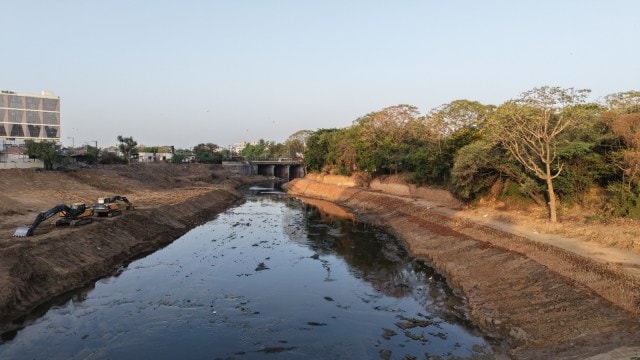How Vadodara avoided floods from Vishwamitri river despite record rainfall
A scientifically planned reservoir management and massive desilting drive helped the city in Gujarat withstand a monsoon that exceeded rainfall averages by over 100 per cent.
 A scientifically planned reservoir management and massive desilting drive helped the city withstand a monsoon that exceeded rainfall averages by over 100 per cent (File Photo)
A scientifically planned reservoir management and massive desilting drive helped the city withstand a monsoon that exceeded rainfall averages by over 100 per cent (File Photo)On September 7, even as the water level in the Vishwamitri River rose to 23 feet at the Kala Ghoda bridge in Vadodara, bringing the city on edge, officers in the Vadodara Municipal Corporation (VMC) confidently reassured citizens that the rise in the river was “controlled.”
Vadodara city has already witnessed heavy rainfall this season, higher than the ten-year average. Its catchment areas, from where water flows into the Vishwamitri, recorded nearly 152 per cent more rainfall than the ten-year average. Compared to last year, the city had received 85 mm more rainfall, though in a staggered manner.
A scientifically backed water management strategy — including continuous release of water from the Ajwa and Pratappura reservoirs, coordination with the water supply department, and a massive pre-monsoon dredging and desilting drive along the Vishwamitri River that increased its carrying capacity by nearly 400 cumec — helped Vadodara avert a flood in the monsoon of 2025.
For the first time, the VMC did not even have to evacuate residents from the most flood-prone low-lying areas along the river.
According to official data, Vadodara recorded 113.34 per cent higher rainfall at 1,012.7 mm against the ten-year average of 893 mm, and its catchment areas outside the city recorded 152.60 per cent higher rainfall at 1,388 mm against the average of 909 mm.
VMC Commissioner Arun Mahesh Babu said that a planned release of water from the Ajwa and Pratappura reservoirs throughout the season allowed the civic body to maintain desired and calculated river levels, even though the Vishwamitri catchment witnessed far higher rainfall than the average.
“The key was the management of the reservoirs. We released water from Ajwa about four times and decided to maintain the water at 213.75 feet when the river needed time to drain. There was some apprehension about maintaining the higher level, but we did it scientifically after checking the dam strength. This was also recommended by the Navalawala Committee report,” Babu said.
Following severe flooding in Vadodara, in 2024, the state government had appointed an expert committee headed by B N Navalawala to investigate the causes and propose solutions.
Ajwa reservoir overflows beyond 213.85 feet — its maximum level, beyond which the release cannot be controlled. “Ajwa and Pratappura were released alternately and in coordination with the irrigation department. We kept an eye on the water flowing into the Dhadhar River and coordinated with the irrigation department to ensure that water was released from different areas in a synchronised manner so that the flow was smooth. We also considered factors such as the full moon, when the water movement is influenced by gravitational pulls. We took logical decisions to manage the rainfall in the city as well as in the catchment areas,” he said.
According to Babu, the continuous pumping out of water from 216 vulnerable points in the city also helped reduce waterlogging. “As soon as there would be rain-caused waterlogging in the identified spots, our team would get there and pump out the water. It helped that all the connected networks of stormwater drains had also been desilted. It kept the water flowing continuously, with a 47 per cent increase in the overall carrying capacity of the river. We were able to absorb all the rainfall we received without a hitch,” he said.
Key catchment areas of the Vishwamitri river such as Ajwa, Pratappura, Rupapura, Gopipura, Madar, Gutal, Tajpura, Halol, and Asoj all received over 100 per cent higher rainfall than the ten-year average. While Halol recorded 171.23 per cent higher rainfall at 1,524 mm, Madar and Gutal witnessed 180.94 per cent and 171.21 per cent higher rainfall, respectively. Asoj, another crucial catchment point, also received 140.61 per cent higher rainfall.
Babu added that compared to 2024, the city received 85 mm more rainfall in 2025, but the Vishwamitri did not breach the vulnerable areas. “In 2024, the city recorded 1,708 mm of rainfall and this year, it was 1,793 mm, which is 85 mm more. The only difference between last year and this year was that the rainfall in 2025 came with small pauses, although it was higher. But the main reason for being able to mitigate flooding was the management of the reservoirs and maintaining the cushion for adverse situations when rainfall would occur within a short span,” he said.
Babu said that the next step for the VMC is to implement the Navalawala Committee report, which “in letter and spirit” provides recommendations for a flood-proof city. “Desilting and dredging were only the first steps. The next important aspect is plugging the drainage lines so that untreated water does not go into the Vishwamitri. We have identified 12 points along the river course where gabion structures have to be built and a soft turf will be created to bind the soil and make the riverfront. It will be followed by planting grass turfs, cycle tracks, smaller gardens, and long walking tracks that will help us revive the ecosystem,” he said.
The VMC has also taken on board a four-member team from IIT Roorkee to examine the water supply and drainage networks as well as the flood mitigation plan, and to prepare a comprehensive report to assist the civic body in implementing projects for better use of natural resources. “The experts will give us a long-term model — a sensor-based water flow management system,” Babu said.







